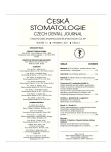Cephalometric Norms of Czech Population Sample
Authors:
A. Řeháček 1; M. Janega 1; P. Hofmanová 2; P. Michalík 2; T. Dostálová 2
Authors‘ workplace:
Stomatologická klinika 1. LF UK a VFN, Praha
1; Dětská stomatologická klinika 2. LF UK a FN Motol, Praha
2
Published in:
Česká stomatologie / Praktické zubní lékařství, ročník 111, 2011, 6, s. 103-109
Category:
Original Article – Statistical Study
Overview
Objective:
Term standard cephalometric values mean average value of cephalometric measurements which includes standard deviation. This is not an absolute number but the range of values, which were obtained by measuring the defined sample of the population.
Material and Methods:
The sample of the population in our study group was selected from patients of Charles University, 2nd Medical Faculty, and Department of Orthodontics. Selection criteria were: Class I occlusion, balanced facial profile, no previous orthodontic treatment, absence of denture, including dental implants. From the homogeneity point of view the probands were born in Czech Republic and belong to Caucasian population. 91 patients were evaluated (age range was from 18 to 45 years; 21 men and 70 women) in computer program – Dolphin imaging using McLaughlin cephalometric analysis.
Results:
The results showed that our patients are in Class I but position of lower frontal teeth is similar to compensatory mechanisms of Class II patients.
Key words:
dentistry – orthodontics – cephalometric norm – Caucasian population
Sources
1. Ballard, C. F.: Morphology and treatment of Class II division 2 occlusions, Trans. Eur. Orthod. Soc., 1956, s. 44–55.
2. Bishara, S. E.: Longitudinal cephalometric standards from 5 years of age to adulthood, Am. J. Orthod., roč. 79, 1981, s. 35–44.
3. Bjork, A.: The face in profile. Svensk. Tandlakare Tidskrift, roč. 40, 1947, No. 5B.
4. Broadbent, B. H.: A new X-ray technique and its application to orthodontia. Angle Orthod., roč. 1, 1931, s. 45–66.
5. Broadbendt, B. H., et al.: Bolton Standard soft Dentofacial Development Growth, Mosby Zdar Book, St Louis., 1975.
6. Downs, W. B.: Variations in facial relationships: thein significance in treatment and prognosis. Am. J. Orthod., roč. 34, 1948, s. 812–840.
7. Hofrath, H.: Bedeutung der Röntgenfern und Abstands Aufnahme für die Diagnostik der Kieferanomalien. Forstchr. der Orthod., roč. 1, 1931, s. 231–258.
8. MacAllister, M. J., Rock, W. P.: The Eastman Standard incisor angulations: are they still appropriate? Br. J. Orthod., 19, 1992, s. 55–58.
9. McNamara, J. A. Jr., Ellis, E. Cephalometric Analysis of untreated adults with ideal facial and occlusal relationships. Int. J. Adult Orthodon. Orthognath. Surg., 3, 1988, s. 221–231.
10. Peck, H., Peck, S.: A concept of facial aesthetics. Angle Orthod., 20, 1970, s. 168–178.
11. Riolo, M. L., et al.: Cephalometric Standards from the University Schoul Growth Study, Craniofacial Growth Series, Monograph No. 2, Centre for Human Growth and Development, University of Michigan, Ann Arbor, 1974.
12. Řeháček, A., Janega, M., Dostálová, T., Hofmanová, P.: Kefalometrická analýza (Souhrnný referát). Čes. Stomat. a Prakt. zub. Lék., roč. 57, 2009, č. 5, s. 67–70.
13. Segner, D., Hasund, A.: Individualisierte Kephalometrie. Aufl. Hamburg, Germany: Franklin Printing and Publishing House Ltd, 1994.
14. Steiner, C. C.: Cephalometrics for you and me. Am. J. Orthod., 39, 1953, s. 729–755.
15. Tailor, W. H., Hitechcock, H. P.: The Alabama analysis. Am. J. Orthod., 52, 1966, s. 245–265.
16. Mills, J. R. E.: Principles and Practice of Orthodontics. Churchill Livingstone, Edinburgh, 1982.
Labels
Maxillofacial surgery Orthodontics Dental medicineArticle was published in
Czech Dental Journal

2011 Issue 6
Most read in this issue
- The Presence of Microorganisms in the Granulomatous Tissue of Chronic Periapical Lesions
- Skeletal Age in Orthodontics
- Cephalometric Norms of Czech Population Sample
- The Occurrence of Anomalies of the Permanent Maxillary Lateral Incisors in Patients with Ectopically Erupting Permanent Canines
